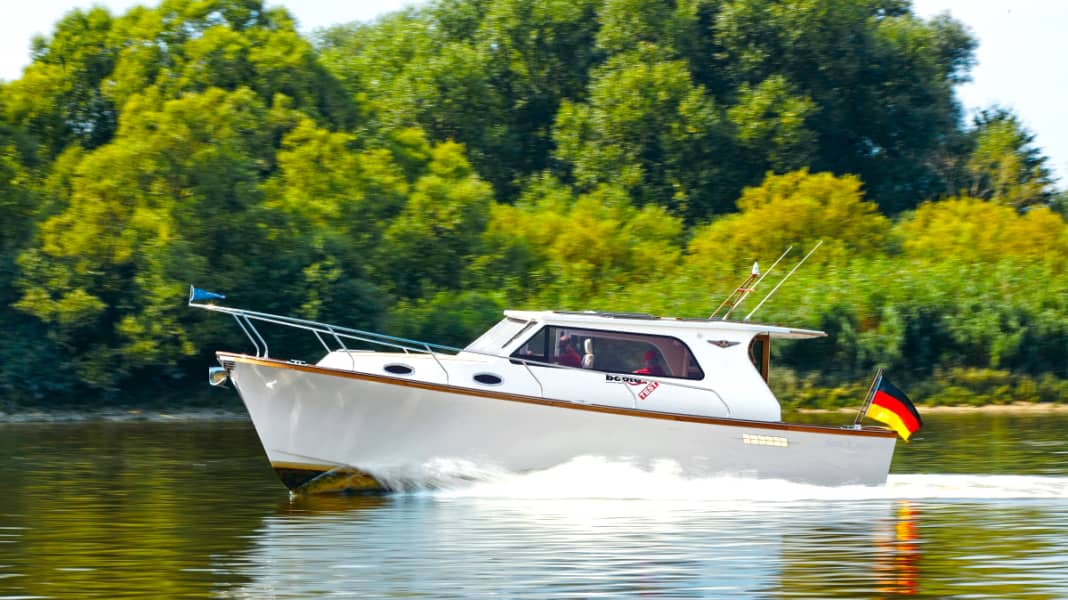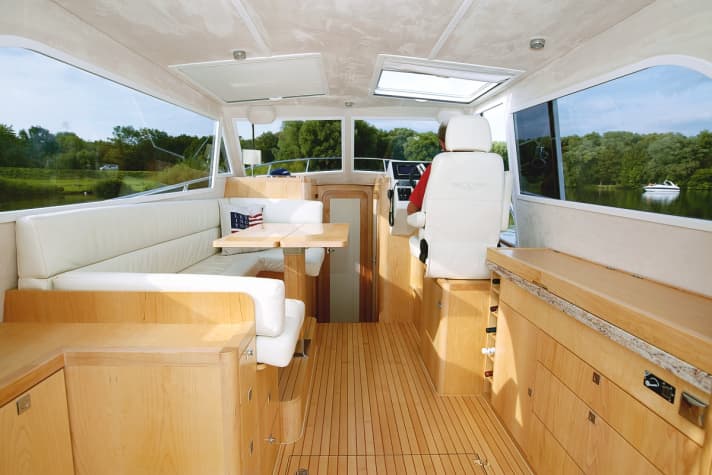
The Christo is not "wrapped" like the works of the artist of the same name, who wrapped the German Reichstag in 1995. But it is still no ordinary boat: fishermen caught lobsters in the North Atlantic on American "lobster boats" that were trained for harsh natural conditions. This earned the boats a good reputation in the leisure yacht sector, which can still be felt today.

Our test boat is intended more for travelling and discovery tours that may also take place outside of coastal waters, which the shipyard documents with CE category B. The shipyard is based in Berlin and is supported in the construction of the Christo by the Polish-based company "Yacht Service".






Christo Mare has a classic drive design with a built-in diesel engine, reversing gearbox and shaft system. Customers can choose between 110 and 200 hp diesel engines. We travelled with "the golden mean", a Volvo Penta D3-150, which accelerated our test boat on the Elbe (at the entrance to Dove-Elbe) to just under
14 kn (on average) at 3150 rpm, which according to the manufacturer is 150 rpm above the recommended full load speed. Our boat was only partially loaded, the speed is reduced somewhat by completely full tanks and a maximum payload of between 600 kg (CE category B) and 1000 kg (CE category D).
The plastic finish on our test boat made a very good impression. This applies in particular to the interior with its seamless protective coating and smooth surfaces. On the other hand, there were a few points we didn't like about the fittings: starting with the different gap dimensions on the pantry block, continuing with unclean silicone seams and flaking paint and ending with the missing seal in the stern wall, which can be lowered to the bathing platform. The shipyard has also recognised these points and wants to improve them.
Driving and manoeuvring
Christo Mare has a classic drive design with a built-in diesel engine, reversing gearbox and shaft system. Customers can choose between 110 and 200 hp diesel engines. We travelled with "the golden mean", a Volvo Penta D3-150, which accelerated our test boat on the Elbe (at the Dove-Elbe entrance) to just under
14 kn (on average) at 3150 rpm, which according to the manufacturer is 150 rpm above the recommended full load speed. Our boat was only partially loaded, the speed is reduced somewhat by completely full tanks and a maximum payload of between 600 kg (CE category B) and 1000 kg (CE category D).
With a maximum speed of 14 knots, the Christo Mare is in the semi-planing range and accordingly swallows a lot of diesel. In figures: A consumption of 2.16 l/sm with a tank capacity of 170 l minus 15% reserve results in a range of 67 nm. In displacement cruising at 1750 rpm, the range is more or less acceptable at 134 nm. But then you are only travelling half as fast as at full throttle.
Whether fast or slow, the Christo stays on course in every situation. This even applies in swell with wind force 4 on the Baltic Sea, where colleague Manfred Welkamer has already driven the boat. His "cheat sheet" for rough water sailing also states "soft and dry at around 10 knots". - In fast bends, the hull lays slightly on its side and circles at around three boat lengths without any "bumps".
The steering is very smooth; slalom manoeuvres were hardly possible due to the short gear ratio. Together with the bow thruster (extra), slow manoeuvres are also safe and precise. When reversing, the Christo Mare reacts typically for a boat with a wave system: the turning circles are quite large, and when reversing in one direction (in our case from port to starboard), the turn should be intercepted by engaging the clutch briefly "ahead".
The driver does this using a bracket-mounted gearstick, which is precise and easy to operate. The push-button panel for the bow thruster control is located below the gearstick and is also easily accessible. The same applies to the sports steering wheel. Standing drivers can put their head through the roof hatch and look over the cab roof. However, the 1.80 metre tall driver has his chin and mouth area exactly at the level of the cut-out and must be careful not to bump into the frame in rough seas. Seated drivers enjoy a tightly upholstered sports seat that can be adjusted in all directions and offers plenty of knee room and lateral support.
A good idea is the door next to the driver, which leads directly onto the side deck and makes mooring easier, especially for solo drivers. Large windows provide a good all-round view. In rainy weather, forward visibility is guaranteed by two windscreen wipers with a sufficiently large wiping area. However, the light-coloured surface of the driver's cabin is reflected in the windows, and there are only minor reflections on the instruments. Plus/minus: The engine instruments are standard, the compass is missing on the standard boat.
Engine, tank, electrics
The diesel, which is accessed via a flap held in place by a gas damper, is located under the saloon floor. The space around the engine is moderate, leaving only sufficient room for the service technician. The lines are neatly laid, the diesel tank fitted into the bilge is secured with straps and the hose connections are fitted with two clamps. The additional Volvo Penta filter with sight glass and drain cock is also a guarantee of mobility. Two 110 Ah batteries, battery charger and shore connection (both at extra cost) ensure a reliable power supply. The batteries are switched via a relay and Philippi touchscreen control panel (saloon input), next to which the circuit breakers are also located. Emergency main switches for manual operation can be found in the stowage box under the cockpit floor.
Security
The shipyard relies on electric and hand pumps for the bilge pumps. Equally exemplary is the equipment with a fire extinguishing system in the engine compartment and a 2 kg hand extinguisher. Further praise goes to the double-locking, easily accessible quick-closing valves, non-slip cockpit floor, side and foredeck as well as good handrail and railing handholds. In the event of a steering failure, the bypass valve and emergency tiller ensure that the boat remains manoeuvrable. Anyone who goes swimming without first hooking up the loose ladder will have a problem climbing back into the boat. The shipyard has also recognised this shortcoming and intends to equip future models with an emergency ladder at the stern.
Living and equipment
The seating in the cockpit is made up of simple rear boxes. The saloon is more upmarket with a U-shaped sofa and folding table as standard - although the sofa ends are more comfortable than those in the longitudinal direction due to their deeper cushions. Opposite is the "fully equipped" galley. The wet room is lined with green mosaic tiles and makes an extraordinary impression. The space is well sized and suitably equipped for a 1.80 metre tall person. The toilet bowl deserves special praise for its generous dimensions.
The forward cabin is a pleasant size and has suitable storage space; however, there is no ventilation under the particularly firm mattress. The entire space is supplied with fresh air through portholes and escape hatches (all with fly screens). Guests sleep in the underfloor cabin with the same upholstery as in the front; in the berth area the distance between ceiling and floor is a good 1.00 m and in the entrance area, where there is a cupboard, 1.81 m. - The safe is a special request. Additional accessories include an electric windlass, holding tank, boiler, ceramic hob, Wallas diesel, stern shower and 12/230 V inverter.
The shipyard says...
Thanks to its hull, the Christo Mare 31 allows for both comfortable water travel with maximum stability and fast cruising with extremely moderate fuel consumption. At the same time, it always remains extremely directionally stable and easy to control at all times. Easy handling, plenty of space, maximum comfort and top quality are all part of the specification. Rarely has a yacht aroused such emotions.
We say...
We agree that the Christo Mare 31 offers a beautiful design and a pleasant life on board. We also agree with the handling characteristics, but the range is too short for fast cruising. In terms of quality, the plastic workmanship is impressive, but some of the fittings lack the finishing touches.
Data sheet: Christo Mare 31
Shipyard: Christo Mare Yachting
Type designation: Christo Mare 31
CE category: B - Outside coastal waters
Material of hull and deck: Plastic
Length: 10,50 m
Width: 3,00 m
Displacement: 4,30 t
Price: 188.721,00 €

